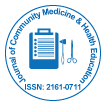The Role of Cumulative Adversity in Maternal Mental Health Outcomes
Received: 07-Mar-2025 / Manuscript No. jcmhe-25-167368 / Editor assigned: 10-Mar-2025 / PreQC No. jcmhe-25-167368 (PQ) / Reviewed: 24-Mar-2025 / QC No. jcmhe-25-167368 / Revised: 31-Mar-2025 / Manuscript No. jcmhe-25-167368 (R) / Published Date: 07-Apr-2025
Description
Perinatal mental health has gained increased recognition in recent years as a vital component of maternal and child health. While much of the current focus remains on immediate risk factors such as hormonal shifts, sleep deprivation or acute stressors during pregnancy and postpartum, a broader life course perspective reveals a more complex and deeply rooted set of influences. Maternal mental health during the perinatal period is not formed in isolation; it reflects an accumulation of psychosocial experiences across a woman’s entire life. Recognizing and addressing these cumulative influences is essential for developing more effective, preventive and compassionate models of perinatal mental health care.
The life course approach emphasizes that health outcomes are the product of dynamic interactions between biological, social and environmental factors experienced from early life through adulthood. For maternal mental health, this means considering not only what happens during pregnancy but also the imprint of childhood adversity, adolescent trauma, socioeconomic hardship, interpersonal violence and cumulative stress exposure over time. A woman entering pregnancy does so with a psychological and emotional history that profoundly affects her capacity to adapt to the demands of childbearing and early motherhood.
One of the strongest predictors of poor perinatal mental health is a history of Adverse Childhood Experiences (ACEs), such as emotional neglect, physical abuse, or household dysfunction. Numerous studies have shown that women with higher ACE scores are more likely to develop depression, anxiety, or Post-Traumatic Stress Disorder (PTSD) during pregnancy or postpartum. These early experiences can dysregulate the Hypothalamic-Pituitary-Adrenal (HPA) axis, impair attachment styles and shape maladaptive coping strategies—each of which can resurface or intensify under the physical and emotional strain of the perinatal period.
Beyond childhood, psychosocial stressors in adolescence and early adulthood further compound risk. Experiences such as intimate partner violence, unstable housing, educational disruption and systemic discrimination are often chronic and intersecting. Women from marginalized backgrounds may carry the psychological residue of racial or socioeconomic marginalization, with limited access to mental health resources even before pregnancy. During pregnancy, these historical and ongoing stressors do not vanish; instead, they can manifest as heightened anxiety, mistrust of healthcare systems, or feelings of vulnerability, which in turn increase the risk for perinatal mood disorders.
Moreover, the life course accumulation of psychosocial experiences influences how women perceive and respond to pregnancy and motherhood. For some, pregnancy may trigger unresolved trauma, particularly in cases where the body becomes a site of distress rather than empowerment. For others, the transition to motherhood might represent the first time they are called to care for another while still healing themselves. The social narrative of maternal joy and resilience often leaves little space for such nuanced realities, pushing many women to suffer in silence or avoid seeking help due to fear of stigma or being perceived as inadequate mothers.
The combined effect of these life course experiences is rarely linear. Instead, they interact in complex ways, with some women demonstrating remarkable resilience despite adversity, while others struggle even in seemingly supportive environments. Protective factors such as strong social support, access to quality prenatal care and previous positive caregiving experiences can buffer against the negative impacts of earlier trauma. However, these protective layers are not evenly distributed and for many women, the burden of past psychosocial stress remains unaddressed in routine prenatal screening or support services.
The standard perinatal mental health model still tends to emphasize current symptomatology—screening for depression and anxiety in pregnancy or postpartum using short self-report scales. While these tools have utility, they fall short of capturing the broader psychosocial history that underlies many perinatal mental health challenges. What is needed is a shift toward trauma-informed, life course oriented care, in which providers assess not only present symptoms but also the context in which those symptoms arise. Asking about a woman’s past, her sense of safety, her social environment and her access to support should be standard practice, not a supplementary concern.
In conclusion, maternal perinatal mental health cannot be fully understood or addressed without considering the combined effects of life course psychosocial experiences. These accumulated influences shape vulnerability, resilience and the ability to access and benefit from care. By broadening our lens to include these deeper and often hidden narratives, we can foster more empathetic, effective and equitable maternal mental health care. Pregnancy and early motherhood are not isolated events, but chapters in a much longer story—one that deserves to be heard, honored and supported at every stage.
Citation: Nowak J. (2025) The Role of Cumulative Adversity in Maternal Mental Health Outcomes. J Community Med Health Educ 15:931.
Copyright: © 2025 Nowak J. This is an open-access article distributed under the terms of the Creative Commons Attribution License, which permits restricted use, distribution, and reproduction in any medium, provided the original author and source are credited.
Select your language of interest to view the total content in your interested language
Share This Article
Recommended Journals
Open Access Journals
Article Usage
- Total views: 300
- [From(publication date): 0-0 - Oct 29, 2025]
- Breakdown by view type
- HTML page views: 233
- PDF downloads: 67
